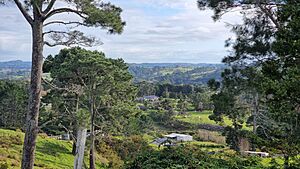Pāremoremo facts for kids
Quick facts for kids
Pāremoremo
|
|
|---|---|

View from Pāremoremo Road of rural Pāremoremo, looking towards Coatesville
|
|
| Country | New Zealand |
| Region | Auckland Region |
| Ward |
|
| Local Board |
|
| Electorates |
|
| Area | |
| • Total | 1.28 km2 (0.49 sq mi) |
| Population
(June 2023)
|
|
| • Total | 510 |
| • Density | 398/km2 (1,032/sq mi) |
Pāremoremo is a small, mostly rural area in Auckland, New Zealand. It's located about 8 kilometres (5 miles) southwest of Albany. Nearby towns include Coatesville to the north and Riverhead to the west. Pāremoremo is known for being the home of New Zealand's main maximum security prison.
Contents
History of Pāremoremo
Pāremoremo has a special place in the history of the Tāmaki Māori people. It's said that a very important ancestor, Rangi-hua-moa, who was the grandmother of Kiwi Tāmaki, ate the last known moa eggs here. Moa were large, flightless birds that used to live in New Zealand.
In the 1840s, a family named Kelly ran a timber business in Pāremoremo and Albany. Pāremoremo started as a small community on the Upper Waitematā Harbour. More European settlers came after a wharf was built at Attwood Road. In the early 1900s, the area was famous for its farms, market gardens, and orchards. People and goods traveled to the city by small boats and ferries.
In the mid-1960s, Auckland Prison was built here. This is New Zealand's main prison for people who need the highest level of security. The government built a village with 130 houses for the prison workers. Later, in 1996, some of these houses were sold.
People of Pāremoremo
Pāremoremo is considered a rural settlement. In 2023, about 483 people lived in the main settlement area. This was a small decrease from 2018. The average age of people living here was 46 years old.
Most people in Pāremoremo are of European background (Pākehā), but there are also people from Māori, Asian, and other backgrounds. English is the most common language spoken. About 3 out of 10 people living in Pāremoremo were born outside New Zealand.
When we look at the wider Pāremoremo area, including its rural parts, the population was about 3,774 people in 2023. This area is much larger and has more people living in it.
Parks and Fun Places
Pāremoremo has some great natural areas for everyone to enjoy.
Paremoremo Scenic Reserve
The Paremoremo Scenic Reserve is a large area of native bush located north of the main residential part of Pāremoremo. It's the biggest bush reserve in the North Shore area and is very important for its plants and animals. It's a great place to explore nature.
Sanders Park
South of the prison, there's a large park called Sanders Park. It was bought in 2002 and finished in 2010. This park has lots of cool features, including:
- A special fenced area where you can let your dogs run around off-leash.
- Exciting mountain bike trails for cycling enthusiasts.
- A small bike track for younger children.
- A fenced area for people who enjoy horse riding.
- Two small beaches where you can go for a swim. Some people even like to camp on the grass near the beaches!
Education in Pāremoremo
Ridgeview School
Ridgeview School is a primary school for students in Years 1 to 6 (ages 5-11). It's a coeducational school, meaning both boys and girls attend. The school opened in 1923 and was originally called Paremoremo School. Its name changed to Ridgeview in the year 2000.


